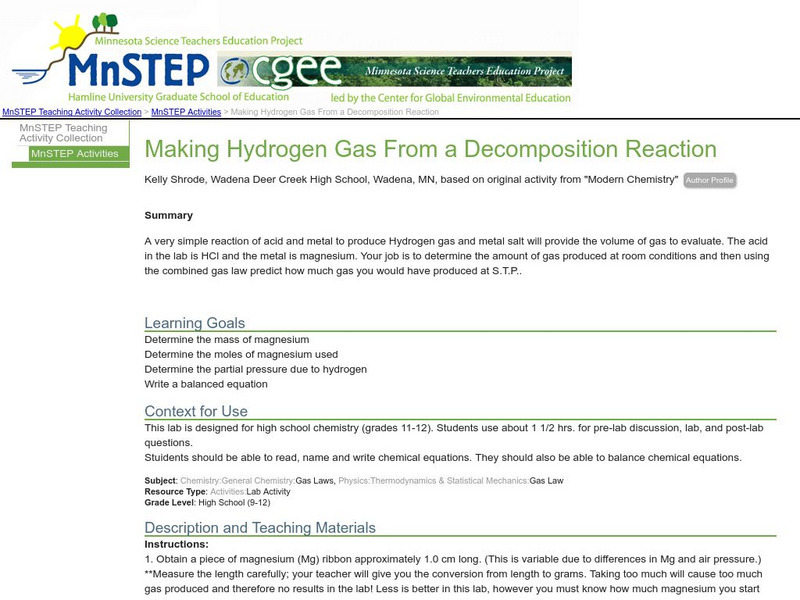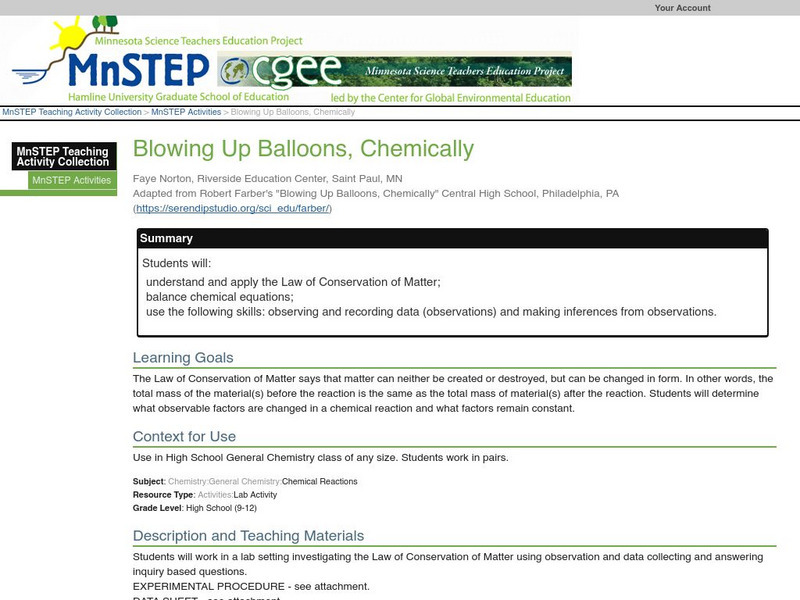Texas Instruments
Texas Instruments: Identifying and Balancing Chemical Equations
This StudyCard stack will allow students to review balancing and classifying chemical equations.
Science Education Resource Center at Carleton College
Serc: How Big Is the Balloon?
A chemistry lab where students investigate limiting reagents and balanced chemical equations. A simple experiment that gives students a physical example of what limiting reactant means.
Science Education Resource Center at Carleton College
Serc: Making Hydrogen Gas From a Decomposition Reaction
A very simple reaction of acid (HCl) and metal (magnesium) to produce Hydrogen gas and metal salt will provide the volume of gas to evaluate. Students will determine the amount of gas produced at room conditions and then using the...
Science Education Resource Center at Carleton College
Serc: Blowing Up Balloons, Chemically
Learners will understand and apply the Law of Conservation of Matter; balance chemical equations; use the following skills: observing and recording data (observations) and making inferences from observations.
Science Education Resource Center at Carleton College
Serc: Chem Prime: Creating a Connection Between Everyday Life and Stoichiometry
Students learn about stoichiometry, and make the connection between stoichiometry and when they use the same mathematical process during their every day life.
Simon Fraser University
Chem1 Virtual Textbook: Chemical Equations and Calculations
As part of the "Basic Atomics" section of the Virtual Textbook, chemical equations are examined here. Equations involving ions and limiting-reactant problems are also discussed.
Crescent Public Schools
The Internet Science Room: Net Ionic Equations
Through example problems and explanation, students learn that net ionic equations attempt to show only the particles involved in a chemical reaction.
Purdue University
Chem Ed: Chemical Reactions
Because atoms are neither created nor destroyed in a chemical reaction, the total mass of products in a reaction must be the same as the total mass of the reactants.
Open Curriculum
Open Curriculum: Introduction to Balancing Redox Reactions
The objective of this article is to introduce how to balance redox reaction chemical equations in neutral solution.
Open Curriculum
Open Curriculum: Introduction to Chemical Stoichiometry
The objective of this article is to teach readers about the basics of chemical stoichiometry.
Thomas Jefferson National Accelerator Facility
Jefferson Lab: Elemental Balancing Act!
Welcome to It's Elemental - Balancing Act! The computer will give you a number of incomplete chemical equations. Balance the chemical equations by selecting coefficients from the pull-down menus. Once you think the equation is balanced,...
Virginia Tech
Types of Equations
After learning about and reviewing the types of chemical equations and rules for balancing, students can practice balancing equations on interactive quizzes.
Chiral Publishing
Chiral Publishing: An Introduction to Chemistry: Chemical Calculations and Equations
This interactive site gives a great overview of equation stoichiometry and conversion between masses of substances. Gives detailed steps to follow for equation stoichiometry and a overall summary of how to do the conversions.
BBC
Bbc: Gcse Bitesize: Chemical Calculations
You should be able to calculate the masses of reactants and products from balanced equations, and the formula of a compound from information about reacting masses.
CK-12 Foundation
Ck 12: Biology: Biochemical Reactions
[Free Registration/Login may be required to access all resource tools.] Introduction to chemical reactions and equations.
CK-12 Foundation
Ck 12: Physical Science: Balancing Chemical Equations
[Free Registration/Login may be required to access all resource tools.] How to balance a chemical equation and using coefficients.
CK-12 Foundation
Ck 12: Physical Science: Chemical Equations
[Free Registration/Login may be required to access all resource tools.] An overview of chemical equations.
CK-12 Foundation
Ck 12: Plix Series: Radioactive Decay: Writing Chemical Equations
[Free Registration/Login Required] Use the provided symbols to generate and build chemical equations. Then answer one multiple choice challenge question about the topic.
CK-12 Foundation
Ck 12: Plix: Balancing Chemical Equations
[Free Registration/Login Required] Before you can balance an equation, you need to count the number of each atom present in the reactants and products. Using the example that is shown here, apply the numbers and table to track how many...
Sophia Learning
Sophia: Chemical Equation: Balancing
Use this narrated tutorial to help understand how to balance a chemical equation using coefficients and leaving formula subscripts unchanged. [9:35]
Sophia Learning
Sophia: Converting From Mass to Particles Using a Balanced Chemical Equation
A narrated screencast explaining how to use a balanced chemical equation to determine the number of particles of a substance given the starting mass of another substance. [4:46]
Other
Chem Team: Stoichiometry: Volume Volume Stoichiometry
Understand volume-volume stoichiometry with these volume-based example problems worked with solutions and explanations.
Thomas Jefferson National Accelerator Facility
Jefferson Lab: Balancing Act!
The computer will give you a number of incomplete chemical equations. Balance the chemical equations by selecting coefficients from the pull-down menus. Once you think the equation is balanced, press the 'Check my answer!' button.
Chem Tutor
Chem Tutor: Chemistry: Reactions
This lesson focuses on chemical reactions including what they are and an explanation of each part of a chemical equation.






















